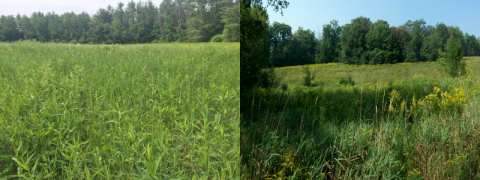Where There are Birds, Bees, and No Trees: Grasslands in New Hampshire

Most of us Granite Staters are enamored, maybe even infatuated, with the forests of New Hampshire. It’s hard not to be. They cover about 84% of the state after all, and include a variety of 86 native tree species that blanket the landscape in a patchwork of leaves and needles, bark and branches.
But every once in a while there’s a break in the canopy. These gaps provide diversity to the forested landscape – many include shrublands, wetlands, rocky areas, or water bodies. And some of these holes in the forest contain a habitat type that is both very important for wildlife and increasingly rare - New Hampshire’s large grasslands.
Grasslands are basically what they sound like – habitats composed primarily by grasses, or a mix of grasses and wildflowers, but containing no trees and few (if any) shrubs. This includes what we might refer to as fields and pastures, but also some areas we don’t typically think of as habitat, like reclaimed landfills and airports. Since around 1950, these habitats have been in decline in New Hampshire and the rest of New England. Development, forest succession, and several other factors have combined to reduce grassland habitats in New Hampshire to the point that grasslands currently cover only about 4%of our landscape. Though, large grassland habitats (those greater than 25 acres in size) still exist in every county in New Hampshire with the highest concentrations in in Grafton County (20% of remaining grasslands), followed by Merrimack County (13%), and Coos County (12%).
Grassland habitats currently account for only 4% of New Hampshire's landscape. Map from NH Wildlife Action Plan.
These unique and valuable habitats are critical for many bird species, but also for other wildlife and plant communities. More than 70 species of wildlife use these open areas of fields and wildflowers to meet their needs for food, cover, or breeding. But as grassland habitats decline, so do many of the wildlife species that rely on them. A total of 23 species associated with grassland habitats were identified as Species of Greatest Conservation Need (SGCN) in the 2015 New Hampshire Wildlife Action Plan. This includes reptiles like the smooth green snake, pollinators like the rusty patched bumble bee, and many grassland birds – those bird species that require large grasslands for nesting, like bobolink, eastern meadowlark, vesper sparrow, grasshopper sparrow, and upland sandpiper. Many common wildlife species also utilize grassland habitats. Black bear and white-tailed deer will take advantage of the early food source provided by grasslands in the spring, some of the first areas to turn green. Turkeys forage in grasslands throughout the year, and common mammals like porcupine, eastern cottontail, and groundhog will feed on young grasses and wildflowers. Different wildlife species will use different grasslands depending on the size of the habitat patch, height and density of the plants, type of plants present, location of the habitat, and the surrounding landscape. Grassland birds, in particular, are ‘area-sensitive’ and require grasslands of a certain size and height/density for nesting. This can range from bobolink, which require grasslands around 5 acres or larger in size and prefer tall (>2.5 ft), dense grasses, to upland sandpipers which require fields larger than 100 acres, with a combination of short grass, tall grass, and patches of bare ground.
Many wildlife species in New Hampshire use grassland habitat, including bobolinks, smooth green snakes, and rusty patched bumble bees.
Grasslands of any size provide valuable habitat for wildlife in New Hampshire, and there are a variety of options for management actions – some which are very simple – that can benefit grassland habitats and the wildlife species that use them. If left alone, grassland habitats will grow back into shrubs and small trees, reverting eventually to forest. Landowners who own fields can maintain them by mowing in the fall at least once every three years to discourage trees and shrubs. The timing of mowing can affect a field’s ability to provide habitat for grassland-nesting birds and other wildlife. Farmers growing forage for livestock usually mow their large fields two or three times during the summer, with at least one of these mowings typically occurring between May and mid-July, which is nesting season for most grassland-nesting birds. Mowing during this period can destroy nests and eggs, kill fledglings, or cause adult birds to abandon their nests. In these fields, modifications to mowing techniques like raising the mowing bar to six inches or more, avoiding mowing after dark, and using flushing bars on haying equipment, can help reduce impacts on grassland-breeding birds during the breeding season. In large grasslands where agricultural production is not a concern, fields should be mowed after August 1st, the end of grassland-breeding bird season. Mowing even later, in September or October is ideal, since this allows late-flowering wildflowers such as aster and goldenrod to provide nectar for bees, butterflies, and other pollinators.
Many landowners own fields smaller than five acres, which are still important for other wildlife species, and as foraging areas for grassland birds nesting in nearby larger fields or migrating songbirds passing through. Landowners can manage their fields to improve the overall plant and wildlife diversity by taking a few simple steps. Mow fields only once every two or three years to increase wildflower and insect diversity, and mow as late in the fall as possible to allow late-blooming wildflowers to form. Some wildlife species, like killdeer, are attracted to areas of bare ground (poor soils or heavily-grazed areas), so maintaining those areas where possible can often be beneficial. Establish a rotational mowing or grazing program in which different parts of a field are mowed/grazed at different times. This creates a patchwork of different grass heights that provides cover and feeding opportunities to the greatest number of wildlife.
Want to learn more about how you can take action for grassland habitats and the wildlife that rely on them? Check out the Grassland Habitat Stewardship Brochure from UNH Cooperative Extension. Read more about Grasslands and associated wildlife species on NH Fish & Game’s Habitat Page, as well as in the Grasslands Habitat Profile from the Wildlife Action Plan. For technical assistance in managing grasslands for wildlife on your property, contact the UNH Cooperative Extension Wildlife Specialist (matt.tarr@unh.edu, 603-862-3594), or your local UNH Cooperative Extension forestry staff. For information about cost-share programs in New Hampshire, contact the Natural Resources Conservation Service (NRCS).


